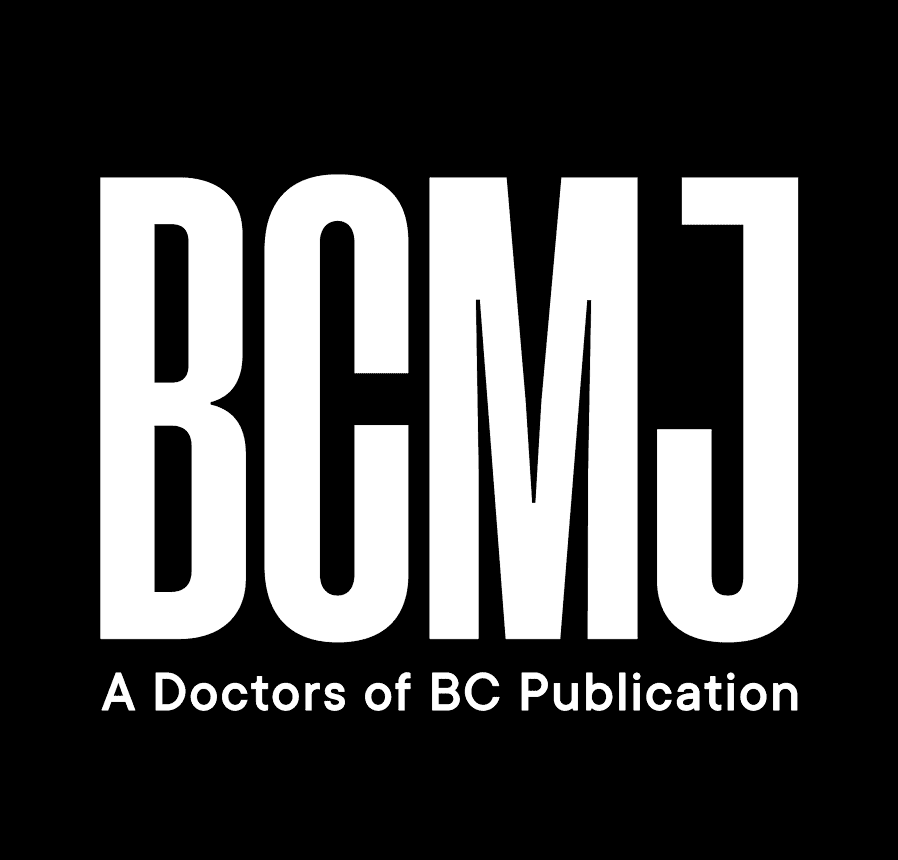Striving for a sustainable, low-carbon health care system
In her October 2022 President’s Comment,[1] Dr Ramneek Dosanjh noted, “As physicians, we are all leaders and trusted advocates for our patients and our communities. Now is the time to use this leadership to communicate about the health impacts of climate change, to contribute to short- and long-term strategies that reduce potential harms, and to actively make changes in the health care system for the good of our patients and our planet.” I am writing to request that the BCMJ further its current impressive leadership[1-6] by including health care sustainability in publication decisions.
Collective recognition of and action on health care’s contribution to 4% of national greenhouse gas emissions[7] and pollution can complement and enhance providing low-carbon, high-quality health care,[8] shifting us out of our unenviable position—second-highest per capita in national health care emissions.[9] The BCMJ has an opportunity to raise awareness by making it policy to consider emissions and pollution-related concerns in its articles. A commentary in Lancet Planetary Health provides eight dimensions that could be adapted for this aim.[10] Centring sustainability for authors and readers may lead to them sharing ideas with patients, who have been shown to support Canadian health systems moving to low-carbon/low-waste care.[4]
Here are two examples of how health care sustainability considerations could have been incorporated into recent articles published in the BCMJ:
- “A call to action: Dermatology’s role in combatting colorism”:[11] If the author had been requested to include sustainability considerations, they would have discovered that many skin-lightening products contain mercury,[12] and a 2022 systematic review demonstrated elevated mercury levels in the urine and blood of skin-lightening product users.[13] This could have been described as a clinical and pollution-related consideration.
- “Implementation of human papillomavirus primary screening for cervical cancer in BC”:[14] Significantly reduced use of single-use plastic specula and quicker detection of cancerous and precancerous conditions would have sustainability co-benefits (less intensive health care with fewer emissions and less waste).[15]
- Some researchers are already thinking about such considerations. For example, Dr Davie Wong, author of “The unsubstantiated preference for outpatient IV antibiotics,” noted that oral antibiotics have a lower carbon footprint than their IV counterparts.[16] The article is about the clinical benefits of oral antibiotics over IV, but it incorporates the environmental co-benefit as well.[17]
In his mandate letter[18] to Minister of Health Josie Osborne, Premier David Eby wrote, “Our commitment to take action on climate change remains foundational and will be key to a healthy and prosperous BC for future generations.” Health authorities have a government-mandated commitment to reduce carbon emissions;[19] therefore, sustainable practices must be embedded in our work. The BCMJ can support this sustainable, low-carbon health care system by identifying environmental sustainability alongside clinical excellence.
—Rashmi Chadha, MBChB, MScCH, CCFP (AM), FASAM
Addictions Physician, Vancouver Coastal Health
Clinician Engagement Lead for Planetary Health, Vancouver Coastal Health
Co-chair, Provincial Sustainable Clinical Services Working Group, Health Quality BC
Editor’s note: Thank you for bringing this up. We will consider how to do this.
hidden
 |
| This work is licensed under a Creative Commons Attribution-NonCommercial-NoDerivatives 4.0 International License. |
References
1. Dosanjh R. Climate change is a health care issue. BCMJ 2022;64:339.
2. Yoshida EM, Harris AC, Cheung KW, et al. Improving planetary health in BC: Taking small but important steps. BCMJ 2022;64:107-108.
3. Courtemanche D. Planetary health versus travel. BCMJ 2024;66:38.
4. Quantz D, Lubik A, Newhouse E, et al. Opportunities for health system action on climate change. BCMJ. 9 August 2023. Accessed 28 March 2025. https://bcmj.org/blog/opportunities-health-system-action-climate-change.
5. Osachoff P. Latest curated reading list: Planetary health. BCMJ 2022;64:322.
6. Chahal JK. Connecting and tree-ting with nature. BCMJ 2024;66:230.
7. Eckelman M, Sherman JD, MacNeill AJ. Life cycle environmental emissions and health damages from the Canadian healthcare system: An economic-environmental-epidemiological analysis. PLoS Med 2018;15:e1002623. https://doi.org/10.1371/journal.pmed.1002623.
8. Barratt AL, Bell KJL, Charlesworth K, McGain F. High value health care is low carbon health care. Med J Aust 2022;216:67-68. https://doi.org/10.5694/mja2.51331.
9. Romanello M, Di Napoli C, Drummond P, et al. The 2022 report of the Lancet Countdown on health and climate change: Health at the mercy of fossil fuels. Lancet 2022;400(10363):1619-1654. https://doi.org/10.1016/S0140-6736(22)01540-9.
10. Herrmann A, Lenzer B, Müller BS, et al. Integrating planetary health into clinical guidelines to sustainably transform health care. Lancet Planet Health 2022;6:e184-e185. https://doi.org/10.1016/S2542-5196(22)00041-9.
11. Gao C. A call to action: Dermatology’s role in combatting colorism. BCMJ 2024;66:367-369.
12. World Health Organization. Countries unite to remove mercury from hazardous skin lightening products. 14 February 2023. Accessed 28 March 2025. www.who.int/news/item/14-02-2023-countries-unite-to-remove-mercury-from-....
13. Bastiansz A, Ewald J, Rodríguez Saldaña V, et al. A systematic review of mercury exposures from skin-lightening products. Environ Health Perspect 2022;130:116002. https://doi.org/10.1289/EHP10808.
14. Gentile L, Smith LW, Smith B, et al. Implementation of human papillomavirus primary screening for cervical cancer in BC. BCMJ 2024;66:375-380.
15. Whittaker M, Davies JC, Sargent A, et al. A comparison of the carbon footprint of alternative sampling approaches for cervical screening in the UK: A descriptive study. BJOG 2024;131:699-708. https://doi.org/10.1111/1471-0528.17722.
16. Wong D. The unsubstantiated preference for outpatient IV antibiotics. BCMJ 2025;67:28-31.
17. Haines A. Health co-benefits of climate action. Lancet Planet Health 2017;1:e4-e5. https://doi.org/10.1016/S2542-5196(17)30003-7.
18. Eby D. Mandate letter to Josie Osborne, Minister of Health. 16 January 2025. Accessed 28 March 2025. www2.gov.bc.ca/assets/gov/government/ministries-organizations/premier-cabinet-mlas/minister-letter/mandate_letter_josie_osborne.pdf.
19. CleanBC. Public sector actions. In: Government actions. Accessed 28 March 2025. https://cleanbc.gov.bc.ca/climate-actions/government-actions/#public-sec....
